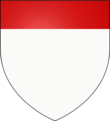Kingdom of Thessalonica
| Kingdom of Thessalonica | |||||
| Βασίλειον Θεσσαλονίκης | |||||
| Vassal of the Latin Empire | |||||
| |||||
|
| |||||
 Kingdom of Thessalonica (1204). | |||||
| Capital | Thessalonica | ||||
| Languages | Latin officially, Greek popularly | ||||
| Religion | Roman Catholic officially, Greek Orthodox popularly | ||||
| Government | Monarchy | ||||
| King of Thessalonica | |||||
| - | 1204–1207 | Boniface of Montferrat | |||
| - | 1207–1224 | Demetrius of Montferrat | |||
| Historical era | Middle Ages | ||||
| - | Kingdom established | 1204 | |||
| - | Fall of Thessalonica to Epirus | 1224 | |||
The Kingdom of Thessalonica was a short-lived Crusader State founded after the Fourth Crusade over conquered Byzantine lands in Macedonia and Thessaly.
History
Background
After the fall of Constantinople to the crusaders in 1204, Boniface of Montferrat, the leader of the crusade, was expected by both the Crusaders and the defeated Byzantines to become the new emperor. However, the Venetians felt that Boniface was too closely tied to the Byzantine Empire, as his brother Conrad had married into the Byzantine royal family. The Venetians wanted an emperor whom they could control more easily, and with their influence, Baldwin of Flanders was elected as emperor of the new Latin Empire.
Establishment
Boniface reluctantly accepted this, and set out to conquer Thessalonica, the second-largest Byzantine city after Constantinople. At first he had to compete with Emperor Baldwin, who also wanted the city. He then went on to capture the city later in 1204 and set up a kingdom there, subordinate to Baldwin, although the title of "king" was never officially used. Late 13th and 14th century sources suggest that Boniface based his claim to Thessalonica on the statement that his younger brother Renier had been granted Thessalonica on his marriage to Maria Komnene in 1180.[1]
The kingdom occupied land along the Aegean coast of Thrace, Thessaly, and Macedonia, but the interior borders were undefined as the kingdom was from the outset constantly at war with the Bulgarians, who wanted to capture the remnants of the Byzantine Empire for themselves, and the Despotate of Epirus, one of the Byzantine successor states. The kingdom initially also faced attacks from the deposed Byzantine emperor Alexius III, who had fled to Corinth, although he was quickly defeated. After this victory Boniface captured the island of Euboea, where a vassal lordship was established, and helped some other Crusaders establish the Duchy of Athens and the Principality of Achaea, which became vassal states of Thessalonica.
The Lombard Rebellion
Boniface's rule lasted less than two years before he was ambushed by Tsar Kaloyan of Bulgaria and killed on September 4, 1207. The kingdom passed to Boniface's son Demetrius, who was still a baby, so actual power was held by various minor nobles of Lombard origin. These nobles, under the regent Oberto, began plotting to place William VI of Montferrat, Boniface's elder son, on the throne, and openly defied the Latin Emperor Henry of Flanders. Henry marched against them in 1209 and forced their submission. As a result, Henry's brother Eustace then became regent for Demetrius.
War with Epirus and fall
Taking advantage of this situation, Michael I of Epirus, a former ally of Boniface, attacked the kingdom in 1210, as did the Bulgarians. Henry of Flanders eventually defeated both, but after Michael's death in 1214, his brother and successor Theodore began anew the assault on the kingdom. Over the next nine years Theodore gradually conquered all of Thessalonica except the city itself, as the Latin Empire could spare no army to defend it while they were busy fighting the more powerful Byzantine Empire of Nicaea in Asia. In 1224, just as Demetrius had become old enough to take power for himself, Theodore finally captured Thessalonica and the kingdom became part of the Despotate of Epirus.
Titular claimants
The kingdom was claimed by titular kings of the house of Montferrat until 1284 and also by the Dukes of Burgundy; Baldwin II of Constantinople had promised the title to Hugh IV should he regain the Latin Empire.
Kings of Thessalonica
- 1204–1207 : Boniface of Montferrat (Boniface I)
- 1207–1224 : Demetrius of Montferrat (Demetrius)
- 1207–1209 : Oberto II of Biandrate, regent
- 1209–1216 : Eustace of Flanders, regent
- 1216–1224 : ..., regent
Titular Kings of Thessalonica
- 1224–1230 : Demetrius of Montferrat (Demetrius)
- 1230–1239 : Frederick II, Holy Roman Emperor (Frederick)
- 1239–1253 : Boniface II of Montferrat (Boniface II)
- 1253–1284 : William VII of Montferrat (William)
- 1266–1271 : Hugh IV, Duke of Burgundy (Hugh I), rival claimant 1266-1271
- 1273–1305 : Robert II, Duke of Burgundy (Robert), rival claimant 1271-1284
- 1305–1313 : Hugh V, Duke of Burgundy (Hugh II)
- 1313–1316 : Louis of Burgundy (Louis I)
- 1316–1320 : Odo IV, Duke of Burgundy (Odo), sold his rights to
- 1320 : Louis I, Duke of Bourbon (Louis II)
Notes
- ↑ E.g. Salimbene de Adam, Chronicle, 1966 edition vol. 2 p. 790. Cf. (Runciman 1951-1954, vol. 3 p. 125), and for full discussion (Haberstumpf 1995, pp. 56–67).
Bibliography
- Haberstumpf, Walter (1995), Dinastie europee nel Mediterraneo orientale. I Monferrato e i Savoia nei secoli XII–XV, Torino
- Runciman, Steven (1951–1954), A history of the Crusades, Cambridge: Cambridge University Press
| ||||||||||
| ||||||||||||||||||||||||||||
| |||||||||||||||||||||||||||||||||


